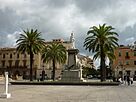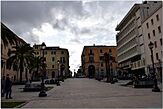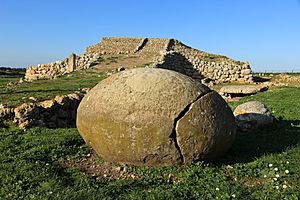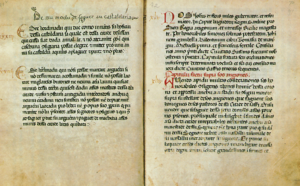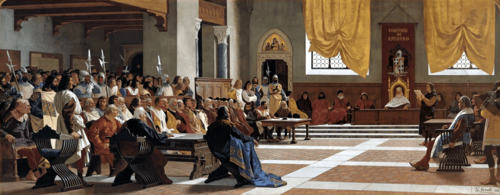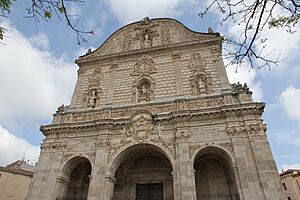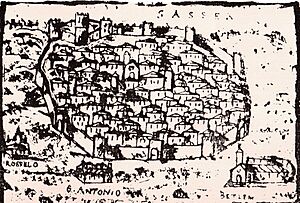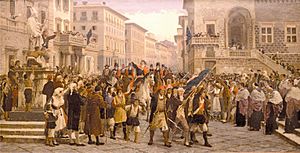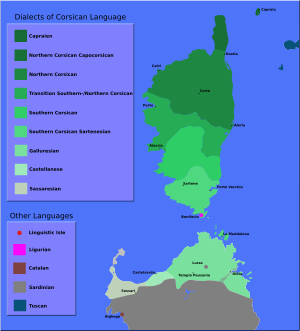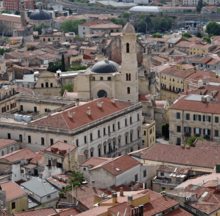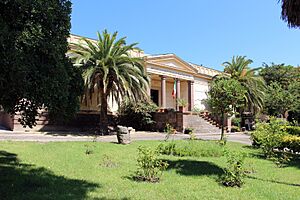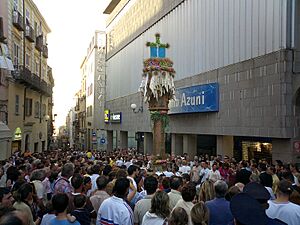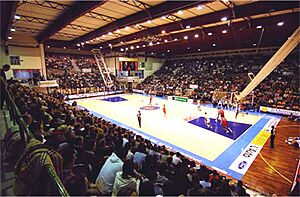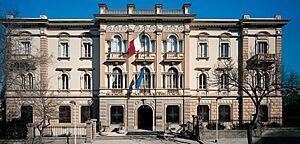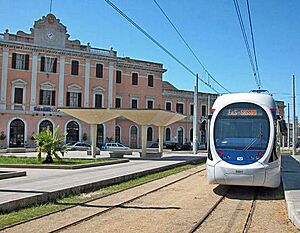Sassari facts for kids
Quick facts for kids
Sassari
|
|||
|---|---|---|---|
| Comune di Sassari | |||
|
From top left: view of the city; Piazza D'Italia; Rosello fountain; Church of Saint Mary of Bethlehem; Piazza Castello; and Cattedrale di San Nicola
|
|||
|
|||
| Country | Italy | ||
| Region | Sardinia | ||
| Province | Sassari (SS) | ||
| Frazioni |
|
||
| Area | |||
| • Total | 546.08 km2 (210.84 sq mi) | ||
| Elevation | 225 m (738 ft) | ||
| Population
(31 December 2015)
|
|||
| • Total | 127,567 | ||
| • Density | 233.6050/km2 (605.034/sq mi) | ||
| Demonym(s) | Sassaresi or Turritani | ||
| Time zone | UTC+1 (CET) | ||
| • Summer (DST) | UTC+2 (CEST) | ||
| Postal code |
07100
|
||
| Dialing code | 079 | ||
| Patron saint | Saint Nicholas | ||
| Saint day | 6 December | ||
Sassari is a large city in Sardinia, Italy. It is the second-biggest city on the island by population. About 127,525 people live there. Sassari is one of the oldest cities in Sardinia. It has a rich collection of art and many beautiful buildings.
Since it began in the 12th century, Sassari has been ruled by different groups. These include the Giudicato of Torres, the people of Pisa, and later the Aragonese and Spanish. Each group added to Sassari's unique history and art. The city is famous for its grand buildings, the Fountain of the Rosello, and its elegant neoclassical architecture. Good examples are Piazza d'Italia (Italy Square) and the Teatro Civico (Civic Theatre).
As a major city in Sardinia, Sassari is important for its culture, tourism, and commerce. The city's economy mostly relies on tourism and services. It also gets income from research, construction, pharmaceuticals, and the petroleum industry.
Contents
History of Sassari
Sassari has a long and interesting history. People have lived in the area for thousands of years.
Ancient Times
Even though Sassari was founded in the early Middle Ages, the land around it has been home to people since the Neolithic Age. Ancient groups like the Nuragics and the Romans lived here. Many old sites are found in or near Sassari. These include the prehistoric step pyramid of Monte d'Accoddi. There are also many Nuraghes (ancient stone towers) and Domus de Janas (fairy houses). You can also find parts of a Roman aqueduct and a Roman villa. A very old human-like ape fossil, called an Oreopithecus bambolii, was found nearby. It is about 8.5 million years old.
The Middle Ages
The exact start of Sassari is not fully known. One popular story says that the first village began around the 9th or 10th century AD. People from the Roman port of Turris Libisonis (now Porto Torres) moved inland to escape attacks from Saracen pirates.
Sassari grew from several small villages joining together. The first time Sassari was mentioned was in a document from 1131. In 1166, the city was attacked by people from Genoa. By the early 13th century, Sassari was the largest city in the Giudicato of Torres.
After the ruler Michele Zanche was killed in 1275, Sassari came under the control of Pisa. But it had some freedom. In 1284, Pisa was defeated by Genoa in a sea battle. Sassari then became the Republic of Sassari. This was the first and only independent city-state in Sardinia during the early Renaissance. It had its own laws, written in 1316. These laws were known for being less harsh than other laws of the Middle Ages.
From 1323, Sassari chose to be on the side of the King of Aragon. The city stayed under Aragonese and later Spanish rule for many centuries. Even though the people revolted a few times, the revolts stopped when King Alfonso V of Aragon made Sassari a Royal Burg. This meant it was ruled directly by the King and did not have to pay feudal taxes. During this time, it might have been the most populated city in Sardinia. In 1391, it was taken over by Brancaleone Doria and Marianus V of Arborea. Sassari became the last capital of the independent Sardinian Giudicato of Arborea.
However, in 1420, Sassari and its land were sold to the Crown of Aragon. After 1479, Spain took over when the Aragonese and Castilian kingdoms joined. During Spanish rule, the city was called Sàsser in Catalan language and Saçer in old Spanish.
Renaissance and Modern Times
The city had good and bad times. There were economic problems and pirate attacks. In 1527, the French attacked Sassari. Two plagues in 1528 and 1652 also caused problems. But there were also times of growth in culture and economy. The Jesuits started the first university in Sardinia in Sassari in 1562. This brought new ideas and a printing press to the city.
After the Spanish rule ended in the early 18th century, Sassari was briefly ruled by Austria. Then, in 1720, it became part of the Kingdom of Sardinia under the Piedmontese rulers. In 1795, there was an uprising against feudal rule led by Giovanni Maria Angioy. Later, the Piedmontese King of Sardinia became the King of Italy. Sassari, like the rest of Italy, became part of the new Kingdom of Italy.
In the late 18th century, the university was reopened. In 1836, parts of the old medieval walls were taken down. This allowed the city to grow. New city plans were made, similar to the capital city of Turin. Sassari became an important industrial center. In the 19th century, it was a leading city in Italy for making leather. The first railway opened in 1872.
In 1877, the old Aragonese castle was torn down. The "Caserma La Marmora" was built there. This is still the home of the "Brigata Sassari", a military unit mostly made up of Sardinian soldiers. At the end of the 19th century, new neighborhoods were built. They showed off new architectural styles like Sassarese Liberty.
During the Fascist period, Sassari grew to over fifty thousand people. New areas like Monte Rosello were built. During Second World War, the city was bombed three times by the Allies, but only the railway station was damaged.
Geography and Climate
Sassari is in the northwest of Sardinia. It is about 225 meters (738 feet) above sea level. The city sits on a large plateau that gently slopes towards the Gulf of Asinara. Sassari is surrounded by many olive plantations. These have replaced some of the older forests. The area has many springs and wells, which has helped farming grow over the centuries.
Sassari's Climate
Sassari has a Mediterranean climate. This means it has hot, dry summers and mild, wet winters.
| Climate data for Sassari, Sardinia | |||||||||||||
|---|---|---|---|---|---|---|---|---|---|---|---|---|---|
| Month | Jan | Feb | Mar | Apr | May | Jun | Jul | Aug | Sep | Oct | Nov | Dec | Year |
| Mean daily maximum °C (°F) | 12.2 (54.0) |
12.5 (54.5) |
14.0 (57.2) |
16.3 (61.3) |
20.1 (68.2) |
24.0 (75.2) |
27.7 (81.9) |
27.8 (82.0) |
24.8 (76.6) |
20.7 (69.3) |
16.2 (61.2) |
13.1 (55.6) |
19.1 (66.4) |
| Mean daily minimum °C (°F) | 6.0 (42.8) |
6.1 (43.0) |
7.0 (44.6) |
8.8 (47.8) |
11.9 (53.4) |
15.4 (59.7) |
18.5 (65.3) |
18.9 (66.0) |
16.6 (61.9) |
13.5 (56.3) |
9.8 (49.6) |
7.0 (44.6) |
11.6 (52.9) |
| Average precipitation mm (inches) | 75 (3.0) |
76 (3.0) |
68 (2.7) |
65 (2.6) |
42 (1.7) |
20 (0.8) |
0 (0) |
17 (0.7) |
54 (2.1) |
98 (3.9) |
96 (3.8) |
85 (3.3) |
696 (27.6) |
| Average precipitation days | 7 | 7 | 7 | 6 | 4 | 2 | 0 | 1 | 4 | 6 | 8 | 8 | 60 |
| Mean monthly sunshine hours | 127 | 152 | 186 | 223 | 270 | 310 | 350 | 316 | 257 | 202 | 143 | 115 | 2,651 |
| Source: globopix | |||||||||||||
Culture in Sassari
Sassari has a rich culture, including its own unique language and many historical sites.
Language of Sassari
The language spoken in Sassari is called Sassarese (Sassaresu or Turritanu). It is more like Corsican and Tuscan language than it is like Sardinian. It started as a mix of languages spoken by early Sardinians, Corsicans, Tuscans, and people from Liguria. This happened during the time of the maritime republics. The original Tuscan language structure was influenced by the local Sardinian dialect. It also took words from Catalan and Spanish.
About 120,000 people speak Sassarese in Sassari and nearby areas. It is also spoken in the northwest of Sardinia, including Stintino, Sorso, and Porto Torres.
Main Sights to See
Sassari has many interesting places to visit:
- The Archeological site of Monte d'Accoddi: This is a unique prehistoric monument with a step pyramid shape.
- The old Pisan City Walls: In the 13th century, these walls surrounded the city and had 36 towers. Only 6 towers remain today.
- The church of St. Peter in Silki: Built in the 12th century, it was updated in the 17th century. Old medieval codes were found here.
- Corso Vittorio Emanuele: This is the main street of the medieval town. It has interesting buildings from different time periods.
- The Cathedral of St. Nicholas of Bari: Built in the 13th century, it was made larger in the Catalan Gothic style. Its front was rebuilt in the Baroque style.
- The church and monastery of Santa Maria di Bètlem: Parts of this building are in the Lombard Romanesque style. Other parts were rebuilt in Baroque and Neoclassic styles.
- The Fountain of the Rosello: Built in 1606 by craftsmen from Genoa. It has two square parts with arches and a statue of St. Gavino.
- University Palace: This building was originally a Jesuit school.
- The Ducal Palace: This is now the Town Hall. It was built for the Duke of the Asinara in the 18th century.
- Piazza d'Italia: This is the main square in Sassari. It is surrounded by beautiful buildings like the "Palazzo Giordano" and the "Palace of Sassari's Province".
- Teatro Verdi: This is an opera house and theater for concerts and plays.
Museums to Explore
Sassari has several museums where you can learn more about its history, art, and science:
- National Archaeological and Ethnographic "G.A. Sanna" Museum
- National Pinacotheca "Mus'A" (Art Gallery)
- Historical Museum of "Brigata Sassari"
- Museum of Science and Technology (with collections of minerals, plants, insects, animals, and more)
- Ethnographic Museum "Francesco Bande"
- Contemporary Art Museum "Masedu"
- Museum and Treasury of the Cathedral
- Museum of History of Sassari
- Museum of Sassari's Diocese
- Museum of Candelieri
- Mario Sironi art collection
- Art gallery "Giuseppe Biasi"
- Pavilion of Sardinian handicraft EXPO "I.S.O.L.A."
Festivals and Traditions
Sassari is known for its lively festivals:
- The Faradda di li candareri (Descent of the Candelieri): This is a special procession where large wooden candles are carried. It celebrates the end of a plague in 1582.
- The Cavalcata Sarda (the Sardinian Cavalcade): This big event happens on the last Sunday of May. Thousands of people from all over Sardinia come to Sassari. They parade through the city in their traditional costumes. Many also ride on hundreds of beautiful Sardinian horses.
- Sardinia Film Festival: Started in 2006, this festival shows many films, short movies, cartoons, and documentaries. It is the biggest film festival in Sardinia.
Sports in Sassari
Sassari is home to several sports teams.
Football (Soccer)
The city has a women's football team, A.S.D. Torres Calcio Femminile, which has won many titles. The main men's football team is S.E.F. Torres 1903. Famous players like Gianfranco Zola started their careers here.
Basketball
Sassari's main basketball team is Dinamo Sassari. They won the Italian League in 2014–15. The club has also won the Italian Cup and the Italian Supercup multiple times. In 2018–19, they won the FIBA Europe Cup.
Handball
- HC Tangram 1 Sassari is a women's handball team that plays in Italy's top league.
Sports Facilities
The city has the Stadio Vanni Sanna, a stadium used for football matches and concerts. The Palasport Roberta Serradimigni is a large indoor arena. It is where the Dinamo Sassari basketball team plays and also hosts concerts.
Economy and Education
Sassari's economy is mostly based on services. It is an important administrative center for northern Sardinia. The main Sardinian banks have their headquarters here.
Many research centers are located in Sassari. These include university centers and labs for environmental protection and animal production. The city also has industries like construction, pharmaceuticals, and food production. Tourism is important, especially along the coasts. Popular beaches include Platamona, Porto Ferro, and Argentiera.
University of Sassari
The University of Sassari is the oldest university in Sardinia. It was founded by the Jesuits in 1562. It is well-known for its programs in law, veterinary medicine, medicine, and agriculture. The university libraries hold many old documents. These include the condaghes, which were Sardinia's first legal codes and the first documents written in the Sardinian language. The famous Carta de Logu, an important constitution, is also there.
In 2009, the University of Sassari was ranked as the best "medium-sized" Italian university.
Transportation
The closest airport is Fertilia International Airport, about 25 kilometers (15.5 miles) from Sassari. The nearest seaport is in Porto Torres, about 16 kilometers (10 miles) away.
Public transport in Sassari includes about 25 bus lines. There is also a light rail transit system. Two different railway companies connect Sassari to other parts of Sardinia. You can travel by train to Porto Torres, Oristano, Cagliari, Olbia, and Alghero.
Major roads connect Sassari to other cities like Porto Torres, Cagliari (via the SS131), and Olbia (via the SS199).
Notable People from Sassari
Many famous people were born in Sassari. These include former presidents of Italy, Antonio Segni and Francesco Cossiga. Enrico Berlinguer, a well-known political leader, was also born here.
|
Historical Figures
|
Modern Personalities
|
Sister Cities
Sassari has special connections with other cities around the world. These are called "sister cities":
- Gorizia, Italy, since 1983
- Timișoara, Romania, since 1990
- Gubbio, Italy, since 2002
- Viterbo, Italy, since 2006
- Nola, Italy, since 2006
- Palmi, Calabria, Italy since 2006
- Napoli, Italy since 2009
- Campobasso, Italy since 2009
- Barcelona, Spain, since 2010 (an "artistic twinning")
Images for kids
See also
 In Spanish: Sácer para niños
In Spanish: Sácer para niños



